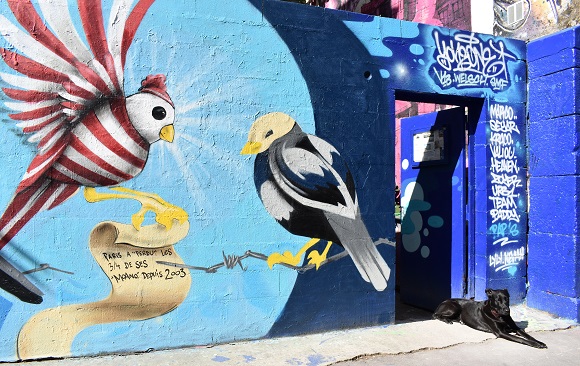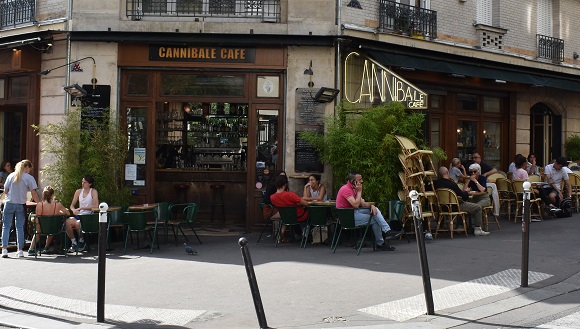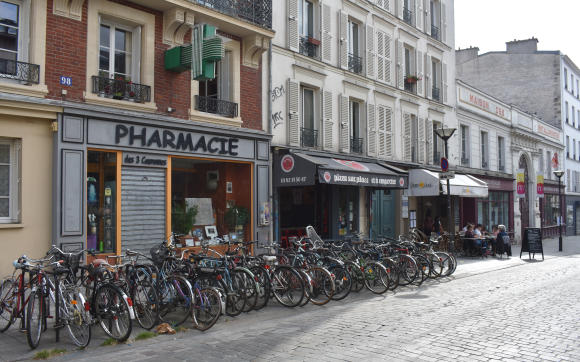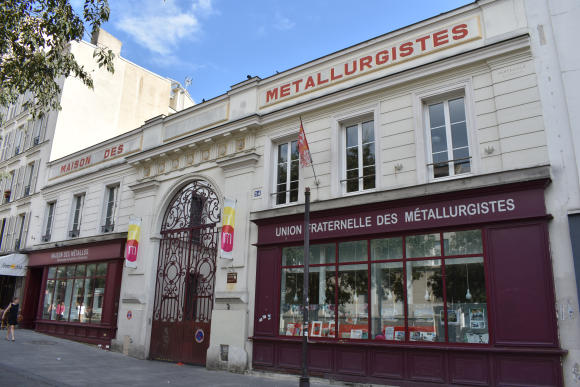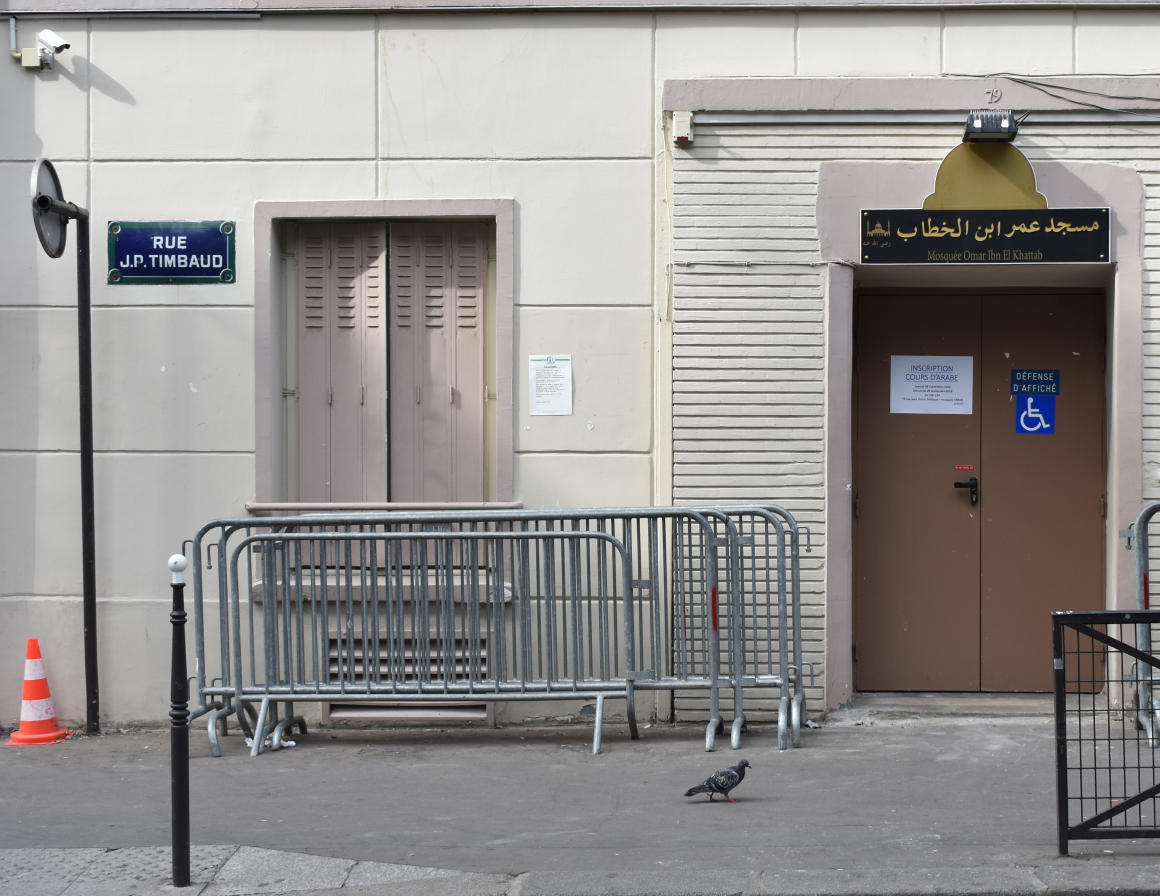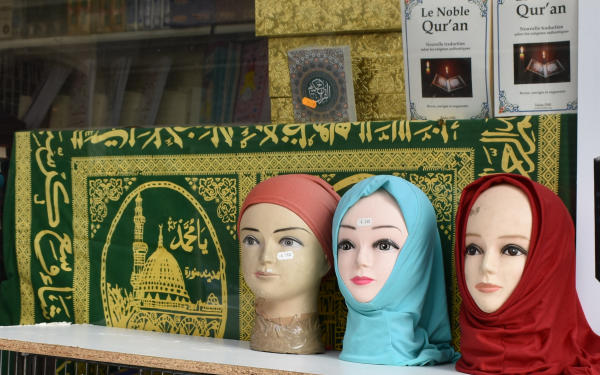
Some call it a no-go zone full of potential Islamist terrorists. Others pretend that the neighborhood is just one big hipster playground. What’s really going on at the eastern end of Jean-Pierre Timbaud? Here, in a two-part illustrated vignette, is what two American travelers discover as they explore eastern Paris after brunch one Sunday afternoon.
Preface
For over 150 years, from the mid-19th century to the early 2000s, eastern Paris was been home to a dense, working-class population, both native and immigrant, including Italians, Jews from eastern Europe, Portuguese, Muslims and Jews from North Africa, Southeast Asians and Chinese, and others. But as real estate pressures in Paris have pushed prices upward, recent arrivals to the area are more likely to be professionals and entrepreneurs with easy access to 20-30-year bank loans.
Part 1: Chadors, Communists, Cannibals
On a bright and quiet Sunday afternoon, two visitors in Paris, strolling down rue Jean-Pierre Timbaud in the 11th arrondissement after languishing over brunch at Benoît Castel further up the hill, were surprised to come upon several shops selling head scarves, formless robes and Muslim prayer rugs.
Hajibs, she said. Shaylas, khimars, chadors, abayas.
Are those vocabulary words we were taught at the Alliance Française? he said. They’d met the previous fall in a conversational French class at the Alliance back home.
No, I learned them from my friend Shandra in yoga class.
How about burkas? he said.
I don’t see any burkas. You can’t wear them in the street in France, so maybe they’re sold in the back.
There were pictures of the Koran and of Mecca in one window. There was an Arab-language bookstore across the street.
Is this the hipster area you wanted to show me? he asked.
It’s the right street, Jean-Pierre Timbaud, but I didn’t expect to find Islamic shops, she said.
Or is it Islamist? he said.
Depends on who’s wearing them or is making their women wear them. Some just call them modest.
Yeh, he said, Isis.
She was blonde, athletic, in her late-40s, and wore a purple-and-yellow-striped knee-length summer dress. He was a few years older, in decent shape for a CFO, wearing knee-length shorts and a polo shirt.
He removed the cap from his Nikon and took a picture of the headless mannequins.
Among the articles that she’d printed out to bring on this 6-day trip to Paris she’d brought along two to guide them today. One was an article about Benoît Castel, the pastry chef in whose shop they’d just enjoyed an excellent brunch, from France Revisited. The other was an article about hipster hangouts and trendy boutiques on rue Jean-Pierre Timbaud from The New York Times. She took out the Times article and looked at it again.
Strange, she told him, this doesn’t mention anything about Arab shops in the neighborhood.
He was now taking a picture of the Cannibale Café whose terrace splayed across a street corner at the base of a handsome beige brick building. It was one of those nonchalant café terraces that makes you want to live in Paris.
These people don’t looked like they shop for chadors, he said of the men and women scattered among the outdoor seating.
Cannibals, she said with a laugh. That’s more like it.
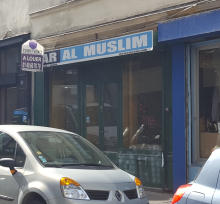 Walking on, they look down an opposite side street.
Walking on, they look down an opposite side street.
Bar Al Muslim, he read. I didn’t think Muslims were supposed to drink alcohol.
Dar, she said. There must be a D behind the “For rent” sign. Dar. It means place or something like that.
How do you know that?
I’ve had a life, sweety.
They were both divorced, with grown children. He had learned French while in Brussels for work for three years. She had studied French in high school and college and had continued to learn the language when she and her ex-husband lived in Lyon for two years for his job. They began dating a few weeks after meeting in French class at the Alliance Française. This was their first trip to Paris together. They both felt that their French was quite passable and headed toward fluency. They tried to refrain from correcting each other’s mistakes and pretended not hear each other’s accents. He never let on that he thought his French better than hers; she never let on that she thought hers better than his.
Just ahead the street open to a long square formed by the juncture of two nearly parallel streets.
Here we are, she said.
There were lots of bikes parked on one side, and near them a pharmacy, a pizza place, and a café called L’Arbre Jaune, the Yellow Tree. Seated in the café were the same types people as at the Cannibale, the same that stood in line for brunch at Benoît Castel, the kinds they both thought of as Parisian.
Beyond the Yellow Tree café was a building called Maison des Métallurgistes, which was divided into two parts. While she looked in at the part indicated as a cultural center operated by the city, he walked on to the other part.
He was examining the window display of what looked like Soviet-era pictures when she came over to him.
Metal workers union, he said.
Steelworkers, she corrected.
Right, steelworkers. Communists.
Are you reading that or just saying that.
Remembering that, from French class.
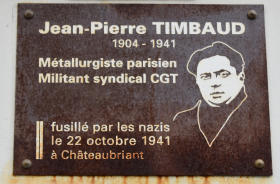 That’s the name of the street we’re on, she said, pointing to a plaque dedicated to Jean-Pierre Timbaud.
That’s the name of the street we’re on, she said, pointing to a plaque dedicated to Jean-Pierre Timbaud.
Parisian steelworker, she read, union militant CGT.
CGT, that’s the name of the union here. Communists.
Killed by the Nazis.
By the bus stop, where a woman with a head scarf waited beside a woman in a bright red-and-white African robe, there was a statue.
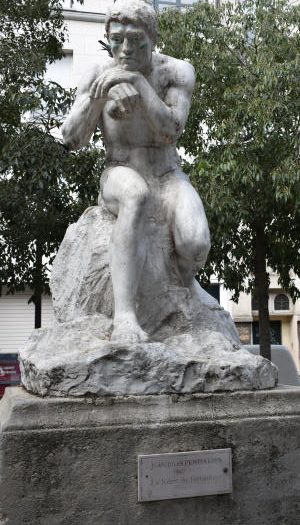 They read the title of the statue but for a moment neither of them ventured a translation because stuck on the word “répit.”
They read the title of the statue but for a moment neither of them ventured a translation because stuck on the word “répit.”
Must be “rest” of the worker, she said.
Respite, he said, of the laborer, with seven weeks paid vacation.
It doesn’t say that, she said, hitting his arm. Silly.
I wonder where Communists go on vacation these days, he said.
They probably vacation in France and complain about the system while enjoying cheese and wine, just like us.
Do I complain about the system?
Well you should. But you won’t as long as the system is lifting your stock portfolio.
My adorable lefty, he said. But you’re right about one thing, he said as two women in gray hajibs walked by in one direction and two African men in knit skullcaps passed in the opposite direction, we’re not in Kansas anymore.
That’s for sure, she said. Not a meth addict or a white supremacist slogan in sight.
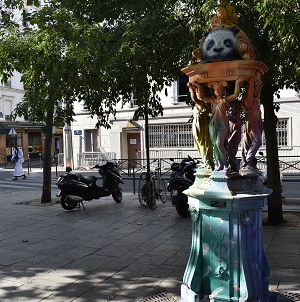 They stood by a multi-colored water fountain observing people crossing the square in one direction or another: men in beige robes and slippers half off their feet; a woman with a green and yellow robe with an infant swaddled on her back; a group of young men in jeans and t-shirts hanging out by the bikes; a man wearing a yarmulke; a biracial couple.
They stood by a multi-colored water fountain observing people crossing the square in one direction or another: men in beige robes and slippers half off their feet; a woman with a green and yellow robe with an infant swaddled on her back; a group of young men in jeans and t-shirts hanging out by the bikes; a man wearing a yarmulke; a biracial couple.
It’s a melting pot, she said.
Some things don’t melt, he said.
I don’t like when you sound like my Nazi brother-in-law.
Just saying, he said. I’m enjoying this as much as you are.
He motioned to the Yellow Tree, where sat men and women dressed the same way they did back home, just neater and in smaller sizes.
It looks like the people in the café were just teleported there, he said, because there’s no one dressed like that walking in the street.
More cannibals, she said, confusing herself with her own joke.
They’d examined the buildings on the one side of the square and now they visited the other. There was a public nursery school next to the Saint Paul Catholic School next to the Omar Ibn El Khattab Mosque.
He’d noticed a sign on the wall of the mosque and got up close to read it. It was a simple but official-looking printed piece of paper with a letterhead in Arabic and a notice in French.
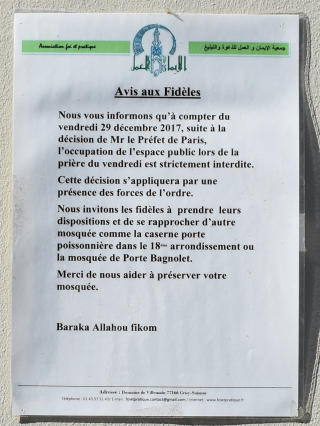 Advice to the faithful, he read aloud.
Advice to the faithful, he read aloud.
Notice, she said coming alongside him. Notice to the faithful.
He continued: We inform you that counting from Friday 29 December 2017, following to the decision of Mister the Prefect of Paris, the occupation of the public space during the prayer of Friday is strictly prohibited.
She took over: This decision will be applied by the presence of forces of order.
Enforced by the police, he said. We invite the faithful to take their dispositions…
To make proper arrangements, and to come close to…
No, to go to another mosque such as the caserne fish shop door…
That must be the name of the mosque—in the 18th arrondisssement or the mosque of Porte Bagnolet.
Thanks for helping us to preserve our mosque.
I wonder if this is where they filmed that video, she said. Every time I post a picture of France on my Facebook page my cousin in Israel sends me the same video of Muslim men praying in the streets of Paris, with the title “America Next” question mark.
She must be friends with my cousin in Oklahoma, he said. When he heard that I was coming to Paris he sent me a video like that entitled “Death to the West.”
They looked around the quiet square. The only people passing by were two joggers in shorts.
It’s a slow death, she said.
Or maybe not, he said.
He pointed to the Amen travel agency at the end of the square, with a picture of Mecca on the wall.
From what I gather, she said, the young professionals are the ones moving in. But what bothers me is that while our cousins tell us that every Muslim is a potential terrorist, the New York Times Photoshops the Arabs out from a travel article about a neighborhood with a mosque and a dozen Muslim shops.
Maybe the Times thought it would scare off American tourists if they mentioned it, he said. Everyone’s got an agenda.
What’s yours?
He winked at her and took her hand.
They both laughed.
God, I love Paris, she said.
Text and photos © 2018, Gary Kraut
Continue to Part 2, The Wall of 3 Crowns.
